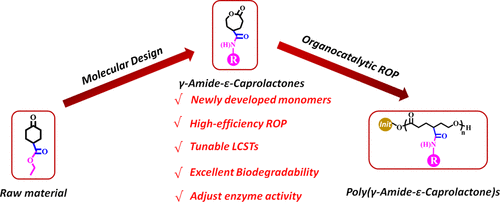当前位置:
X-MOL 学术
›
Macromolecules
›
论文详情
Our official English website, www.x-mol.net, welcomes your
feedback! (Note: you will need to create a separate account there.)
Organocatalytic Ring-Opening Polymerization Toward Poly(γ-amide-ε-caprolactone)s with Tunable Lower Critical Solution Temperatures
Macromolecules ( IF 5.1 ) Pub Date : 2020-07-01 , DOI: 10.1021/acs.macromol.0c00253 Lianlei Wen 1 , Shaoze Zhang 2 , Yan Xiao 1 , Jin He 1 , Shuang Zhu 1 , Jun Zhang 1 , Zihan Wu 1 , Meidong Lang 1
Macromolecules ( IF 5.1 ) Pub Date : 2020-07-01 , DOI: 10.1021/acs.macromol.0c00253 Lianlei Wen 1 , Shaoze Zhang 2 , Yan Xiao 1 , Jin He 1 , Shuang Zhu 1 , Jun Zhang 1 , Zihan Wu 1 , Meidong Lang 1
Affiliation

|
γ-Amide-ε-caprolactones including 7-oxo-N-propyloxepane-4-carboxamide (NNCL), N-isopropyl-7-oxooxepane-4-carboxamide (NICL), N,N-diethyl-7-oxooxepane-4-carboxamide (DECL), and 5-(pyrrolidine-1-carbonyl)oxepan-2-one (VPyCL) were initially designed and synthesized to achieve biodegradable and thermosensitive materials. Ring-opening polymerization (ROP) of these newly developed caprolactones was thoroughly investigated by both theoretical calculation and experimental verification. Density functional theory revealed that the ring-opening enthalpy of γ-amide-ε-caprolactones was more negative than that of γ-ester-ε-caprolactone (EMCL). Experimental results showed that ROP of NICL, DECL, and VPyCL catalyzed by 1,5,7-triazabicyclo[4.4.0]dec-5-ene with benzyl alcohol (BnOH) as an initiator underwent in a living and controlled manner, while that of NNCL and EMCL did not. Computational calculation consistently proved that a variety of substitutions greatly affected the ROP process. PNICL, PDECL, and PVPyCL exhibited reversible lower critical solution temperature-type phase transitions tuned by manipulating the feed ratio and hydrophilicity of comonomers. Furthermore, poly(γ-amide-ε-caprolactone)s with excellent biodegradability and biocompatibility were demonstrated as an enzyme activity regulator, holding great promise for smart biomaterial application.
中文翻译:

可调节的较低临界溶液温度下的聚(γ-酰胺-ε-己内酯)的有机催化开环聚合
γ-酰胺-ε-己内酯类化合物,包括7-氧代-N-丙基氧杂环丁烷-4-羧酰胺(NNCL),N-异丙基-7-氧代氧庚烷4-羧酰胺(NICL),N,N-二乙基-7-氧代氧庚烷-4-最初设计并合成了羧酰胺(DECL)和5-(吡咯烷-1-羰基)氧杂-2-酮(VPyCL),以实现可生物降解和热敏性材料。通过理论计算和实验验证,对这些新开发的己内酯的开环聚合(ROP)进行了深入研究。密度泛函理论表明,γ-酰胺-ε-己内酯的开环焓比γ-酯-ε大。-己内酯(EMCL)。实验结果表明,以苄醇(BnOH)为引发剂,以1,5,7-三氮杂双环[4.4.0] dec-5-烯为催化剂催化的NICL,DECL和VPyCL的ROP活性且受控地发生。 NNCL和EMCL没有。计算计算始终证明,各种替代方法极大地影响了ROP过程。通过控制共聚单体的进料比和亲水性,PNICL,PDECL和PVPyCL表现出可逆的较低临界溶液温度型相变。此外,具有良好生物降解性和生物相容性的聚(γ-酰胺-ε-己内酯)被证明是一种酶活性调节剂,对智能生物材料的应用具有广阔的前景。
更新日期:2020-07-14
中文翻译:

可调节的较低临界溶液温度下的聚(γ-酰胺-ε-己内酯)的有机催化开环聚合
γ-酰胺-ε-己内酯类化合物,包括7-氧代-N-丙基氧杂环丁烷-4-羧酰胺(NNCL),N-异丙基-7-氧代氧庚烷4-羧酰胺(NICL),N,N-二乙基-7-氧代氧庚烷-4-最初设计并合成了羧酰胺(DECL)和5-(吡咯烷-1-羰基)氧杂-2-酮(VPyCL),以实现可生物降解和热敏性材料。通过理论计算和实验验证,对这些新开发的己内酯的开环聚合(ROP)进行了深入研究。密度泛函理论表明,γ-酰胺-ε-己内酯的开环焓比γ-酯-ε大。-己内酯(EMCL)。实验结果表明,以苄醇(BnOH)为引发剂,以1,5,7-三氮杂双环[4.4.0] dec-5-烯为催化剂催化的NICL,DECL和VPyCL的ROP活性且受控地发生。 NNCL和EMCL没有。计算计算始终证明,各种替代方法极大地影响了ROP过程。通过控制共聚单体的进料比和亲水性,PNICL,PDECL和PVPyCL表现出可逆的较低临界溶液温度型相变。此外,具有良好生物降解性和生物相容性的聚(γ-酰胺-ε-己内酯)被证明是一种酶活性调节剂,对智能生物材料的应用具有广阔的前景。











































 京公网安备 11010802027423号
京公网安备 11010802027423号